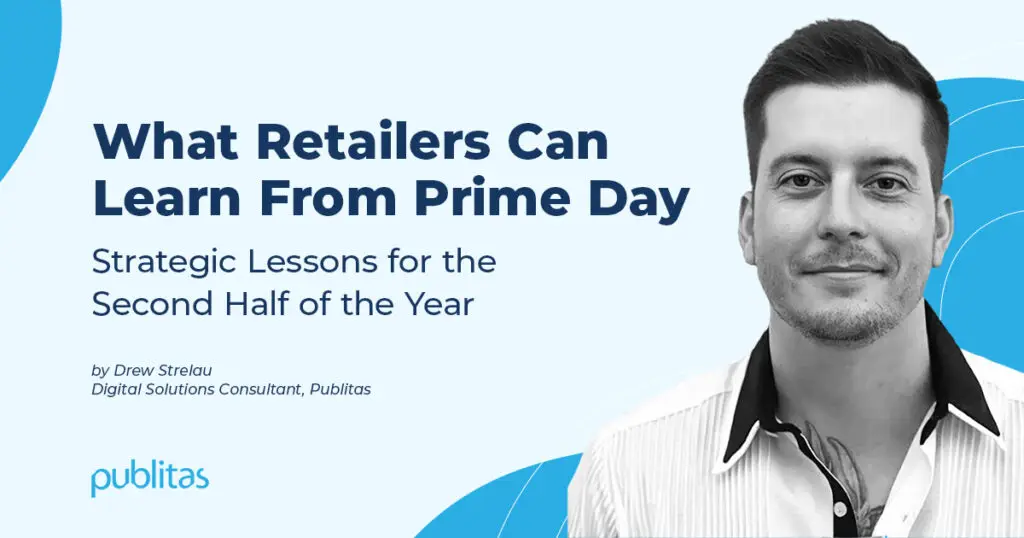By Drew Strelau, Digital Solutions Consultant: Publitas
This year’s Prime Day, now effectively a four-day event, generated $24.1 billion in online sales. While the headlines focused on record-breaking numbers, the real insights lie beneath the surface – in how consumer behavior is evolving and what this reveals about the remainder of the 2025 retail calendar.
Retailers must now recalibrate their strategies for back-to-school, Black Friday, and the holiday season. The key lies not only in understanding what drove Prime Day success, but in using that information to optimize digital campaigns, affiliate strategies, and AI discoverability, particularly in the way catalogs and content are structured and distributed.
Price-Conscious Consumers Are Driving Demand Shifts
In contrast to the deal-chasing consumer of years past, today’s shopper is highly strategic. Inflation and ongoing economic uncertainty are forcing consumers to plan purchases around discount windows. Adobe Digital Insights reported 150 to 200 percent category growth in essentials such as household goods during Prime Day – an indication that consumers are using major events to stock up on basics as much as on high-ticket items.
The implication is clear: consumers are no longer separating daily essentials from promotional events. Retailers should treat digital catalog content as flexible merchandising tools that can address both discretionary and non-discretionary spending behavior. In short, every page should reflect value, not just products.
Promotional Events Are Now the Growth Engine
Year-over-year online spending continues to grow, but more slowly than during the pandemic years. However, promotional events such as Prime Day, Memorial Day, and Black Friday are significantly outperforming baseline e-commerce trends.
Adobe’s data showed a spike in spending across all four days of Prime Day, followed by a return to normal levels. This confirms that consumers are intentionally holding back until promotions go live. In this environment, retailers can no longer rely on a steady-state of demand. Instead, digital activations must be tightly aligned to event-based cycles.
Planning should revolve around these peaks. Retailers can no longer afford to publish static catalogs weeks in advance and hope for sustained traffic. Instead, agile digital content, refreshed to coincide with demand spikes, will be critical.
Generative AI Has Become a Discovery Engine
The most dramatic shift may be the role of generative AI in influencing consumer journeys. Traffic from generative AI platforms to retail sites surged by 3,300 percent year-over-year during Prime Day, according to Adobe. Not only is this traffic increasing, but it converts at a higher rate and has lower bounce rates than traffic from other sources.
This represents a paradigm shift in how product discovery happens. Consumers are now using AI assistants to compare products, request alternatives, and even generate personalized recommendations. The platforms respond by linking directly to retailer websites – provided the underlying content is relevant, well-structured, and visible to the AI.
This has strategic implications. Retailers need to rethink how their catalogs are presented to both consumers and machines. Product data, contextual copy, and even layout hierarchy must now serve dual audiences: human and algorithmic.
Influencer and Affiliate Channels Are Converging with AI
While AI is reshaping discovery, the role of social and affiliate channels is far from diminished. In fact, they’re converging. Affiliate-driven sales during Prime Day grew by 19 percent – far surpassing the 5 percent growth seen in paid search. Affiliate traffic now converts at 10 times the rate of general social media traffic.
This is not coincidental. AI platforms are increasingly drawing from broader media and influencer ecosystems when generating product recommendations. Review content, buyer guides, “top 10” lists, and social sentiment all feed into the models. Retailers that invest in affiliate partnerships and cultivate influencer coverage are more likely to show up in these AI-generated pathways.
Simply put, affiliate and AI strategies are no longer separate; they are now intertwined discovery vectors.
Implications for Digital Catalog Strategy
As these trends converge, the digital catalog is becoming one of the most strategic assets in a retailer’s toolkit. To remain competitive, the catalog must be optimized across three dimensions: discoverability, adaptability, and performance.
1. Discoverability through AI and SEO
Retailers must ensure their catalogs are not only accessible but interpretable by AI models. This means:
- Structuring product content with metadata and semantic tagging
- Publishing catalog links that AI tools can crawl
- Ensuring presence in top-10 listicles and high-authority reviews
Traditional SEO practices still matter, but they now operate in a much broader and more dynamic content ecosystem.
2. Adaptability to Event-Based Cycles
Static catalogs are no longer sufficient. Digital catalogs must evolve in sync with promotional cycles and consumer intent. This includes:
- Updating product selection and pricing dynamically
- Embedding time-sensitive offers
- Incorporating seasonal or category-focused narratives (e.g., back-to-school, holiday gifting)
3. Performance Tracking and Conversion Optimization
Catalog effectiveness should be measured not just by impressions, but by engagement and conversion data. Retailers must:
- Track click-throughs, conversions, and bounce rates
- Segment traffic sources, especially AI-driven and affiliate-referred traffic
- A/B test promotional elements and layout formats to maximize ROI
Looking Ahead: Toward an Intelligent, Responsive Catalog
In a world where consumers are guided by AI, influenced by peers, and operating with heightened price sensitivity, retailers must adapt. Digital catalogs can no longer be treated as static assets. They must evolve into performance-driven, context-aware, AI-optimized experiences that support every stage of the customer journey.
As we enter the most critical retail months of the year, the opportunity is clear: those who align their catalog strategy with emerging behaviors – AI discovery, affiliate influence, and event-based purchasing – will be positioned not only to capture more attention, but to convert it.
About Drew Strelau
Drew Strelau is a Digital Solutions Consultant at Publitas, where he empowers retail brands to transition from print to digital by delivering immersive, sustainable shopping experiences. With a background in customer success, partner enablement, and e-commerce innovation, Drew specializes in driving business transformation through technology. Prior to Publitas, he led strategic customer initiatives at Dropified, where he merged support and success functions to enhance the user journey. Drew combines expertise in marketing communications with a strong focus on operational impact, helping brands engage today’s intentional, digitally savvy shoppers.
Connect with Drew on Linkedin


